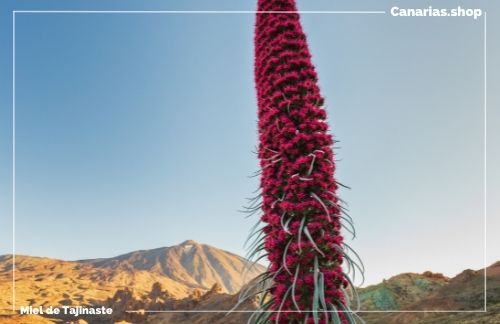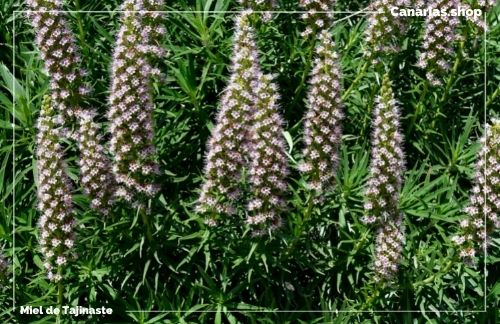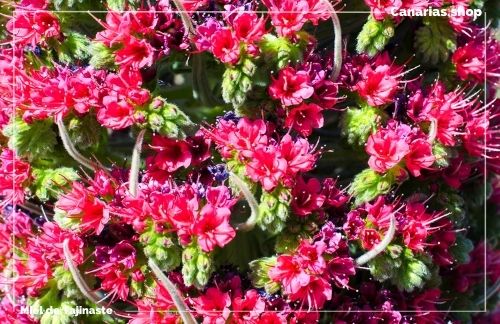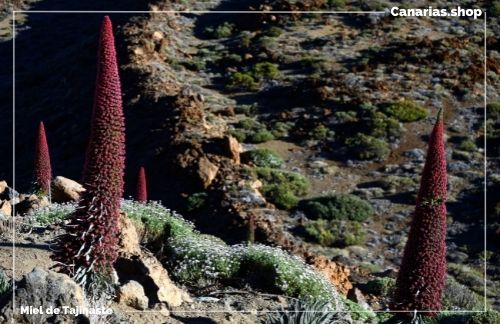Tajinaste Honey
The honey of Tajinaste is considered a rarity of agriculture, it is native to the island of Tenerife and one of the many honeys of this Canarian charm. With a characteristic sweetness and very particular virtues, this honey is a delight to the palate, so this time you will know everything about it.
Tajinaste honey
The Tajinaste is an endemic species found exclusively on the Canary Island of Tenerife, specifically in the adjacencies of Mount Teide. This species, the red tajinaste was scientifically named as Echium wildpretii, since it belongs to this Canarian genus.
It is located exactly in the northeast of the island and its name comes from the Guanche language "tainast" which means "needle" and which makes attribution to the elongated appearance of this species. They are accumulated in forests where pollination takes place and the honey that we know as tajinaste honey is produced.
.jpg)
This is thanks to the fact that the pollen of the red tajinaste flower is one of the favorites of the bees of the island of Tenerife so in this area, you can see one of the largest extensions of hives in all the islands.
It is characterized by being a honey of spring flavor and clear and creamy consistency, you can see a very clear and crystalline coloration with beige tones. Its flavor is especially mild, in the Canary Islands it is usually used as a natural sweetener and in some special dishes.

What you need to know about tajinaste honey
As you can see, tajinaste honey is one of the natural delicacies of the Canary Islands. But today we want to take a walk through several curiosities of this delicious product:
1. The species Echium Wilpreti or red tajinaste is an endemic species, native to the Canary Island of Tenerife, from its nectar the bees produce this unique honey.
2. It is produced by the famous Canarian black bees, a species also endemic to this place, which makes it a unique and exclusive product produced and exported from there.
3. It is considered one of the best honeys in the world

Is tajinaste honey different?
Tajinaste honey is undoubtedly a unique product, for the reasons mentioned above. The exclusivity of the tajinaste flowers that are only found in this Canarian area and the Canarian black bees make it a strange and different honey in flavor, texture, creaminess and oiliness.
If you are passionate about honey native to the Canary Islands, you can find here a selection of honey from the Canary Islands
In addition to this, the Protected Designation of Origin of Honeys of Tenerife has created a standard for tajinaste honey, which gives it the unique seal and accredits it as original.
This standard is based on values of electrical conductivity which is an indicator that yields the content and concentration of mineral salts in honey.

Characteristics
In addition to this standard of electrical conductivity, which must be between 0.140 and 400m S / cm, there are other values that are established by this organization.
Among them is the color value, which is measured through the Pfund scale. On this scale, the coloration of the original tajinaste honey should be between 2 and 65 mm, a characteristic smell for its transparency and beige and amber tones.
The smell is also valued, which must be little intense and with a vegetable character. Its aroma is floral, but not so intense with a very creamy texture.
To pass all these criteria that make tajinaste honey different, the pollen content in honey must also be reviewed, which allows certifying that it is really a product of botanical origin.
Where is tajinaste honey produced?
The red tajinaste, is a species located on the island of Tenerife and native to there by nature. This species is also known colloquially as "blood of Teide" and sometimes by its scientific name "Echium Wildpretii".
This is a shrub that also produces a kind of small rose in the form of a spear that forms a cone, being the lower rosettes longer than the upper ones and red, which can reach 3 meters in height.

Located on the island of Tenerife, in the area of the Cañadas del Teide, they can also be found in other areas such as La Fortaleza, Valle de Ucanca and the surroundings of the Parador Nacional.
In the teide canyons and their adjacencies it could be said that the red tajinaste is the most important and representative species of the area. In the heights of Arico and Arafo it is also very common to see this species and therefore hives of black bees that produce tajinaste honey.
If you are passionate about honey native to the Canary Islands, you can find here a selection of honey from the Canary Islands
Throughout the surface of the island you can see varied climates and especially in the volcanic areas it is surprising to see the hives produced by the black bee of Tenerife.
Beekeeping and pollinators in Tenerife
The abundance of the species Tajinaste Rojo on the island of Tenerife, makes the pollination of this natural. In fact, there are several species in the fauna of the island that are pollinators of Echium wilpretii.

However, the black bee is one of the dominant and largest pollinators of the species, but not as expert or as delicate as other pollinators native to the island.
This, according to some studies can produce a decrease in the production of seeds and fruits of the red tajinaste, since the presence of black bees would decrease other small species that also take advantage of the pollen of this flower.
For this reason, the introduction of more hives for the production of honey could be a bit counterproductive, so it has become necessary to establish a regulation that regulates this activity to preserve both the flora and fauna of Mount Teide in the best possible balance.
In this sense, there are a total of 18 beekeeping settlements that are authorized for this activity within the Teide National Park regulated for the conservation of all species of this territory and to keep the production of tajinaste honey high.
